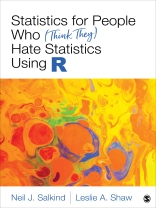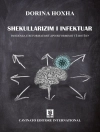Neil J. Salkind’s bestselling Statistics for People Who (Think They) Hate Statistics has been helping ease student anxiety around an often intimidating subject since it first published in 2000. Now the bestselling SPSS® and Excel® versions are joined by a text for use with the R software, Statistics for People Who (Think They) Hate Statistics Using R. New co-author Leslie A. Shaw carries forward Salkind’s signature humorous, personable, and informative approach as the text guides students in a grounding of statistical basics and R computing, and the application of statistics to research studies. The book covers various basic and advanced statistical procedures, from correlation and graph creation to analysis of variance, regression, non-parametric tests, and more.
表中的内容
Preface
Acknowledgments
About the Authors
Digital Resources
PART I • YIPPEE! I’M IN STATISTICS
Chapter 1 • Statistics or Sadistics? It’s Up to You
What You Will Learn in This Chapter
Why Statistics?
A 5-Minute History of Statistics
Statistics: What It Is (and Isn’t)
What Am I Doing in a Statistics Class?
Ten Ways to Use This Book (and Learn Statistics at the Same Time!)
What Else Does This Book Contain?
Summary
Time to Practice
Student Study Site
PART II • WELCOME TO THE INTERESTING, USEFUL, FLEXIBLE, FUN, AND (VERY) DEEP WORLDS OF R AND RSTUDIO
Chapter 2 • Here’s Why We Love R and How to Get Started
What You Will Learn in This Chapter
A Very Short History of R
The Pluses of Using R
The Minuses of Using R
Other Reasons to Use R?
A Short Note to You (and to Your Instructor) About Open Source (Again!)
Where to Find and Download R
Packages and Functions in R
A Note About Formatting
Bunches of Data—Free!
Getting R Help
Getting Help on Help
Some Important Lingo
Where to Find RStudio and How to Install It
Take RStudio for a Test Ride
Ordering From RStudio
Summary
Time to Practice
Student Study Site
Chapter 3 • Using RStudio: Much Easier Than You Think
What You Will Learn in This Chapter
The Grand Tour and All About Those Four Panes
RStudio Pane Goodies
Showing Your Stuff—Working With Menus and Tabs and a Sample Data Analysis Using RStudio
The Basics: +, –, ?, *, and More: Using Operators
Working With Data
Let’s See What’s in the Workspace
Reading in Established Data Sets
Oops! How Do You Correct Console Errors?
Pointing and Clicking to Open a Data Set
Computing Some Statistics
Ten Important Things to Remember About R and RStudio (but Not Necessarily in Order of Importance)
Summary
Time to Practice
Student Study Site
PART III • SIGMA FREUD AND DESCRIPTIVE STATISTICS
Chapter 4 • Computing and Understanding Averages: Means to an End
What You Will Learn in This Chapter
Computing the Mean
Computing the Median
Computing the Mode
When to Use What Measure of Central Tendency (and All You Need to Know About Scales of Measurement for Now)
Using the Computer to Compute Descriptive Statistics
Real-World Stats
Summary
Time to Practice
Student Study Site
Chapter 5 • Understanding Variability: Vive la Différence
What You Will Learn in This Chapter
Why Understanding Variability Is Important
Computing the Range
Computing the Standard Deviation
Step-by-Step
What’s the Big Deal?
Computing the Variance
Using R to Compute Measures of Variability
Real-World Stats
Summary
Time to Practice
Student Study Site
Chapter 6 • Creating Graphs: A Picture Really Is Worth a Thousand Words
What You Will Learn in This Chapter
Why Illustrate Data?
Ten Ways to a Great Graphic
First Things First: Creating a Frequency Distribution
The Plot Thickens: Creating a Histogram
The Next Step: A Frequency Polygon
Cumulating Frequencies
Other Cool Ways to Chart Data
Using the Computer (R, That Is) to Illustrate Data
Real-World Stats
Summary
Time to Practice
Student Study Site
Chapter 7 • Computing Correlation Coefficients: Ice Cream and Crime
What You Will Learn in This Chapter
What Are Correlations All About?
Computing a Simple Correlation Coefficient
Understanding What the Correlation Coefficient Means
A Determined Effort: Squaring the Correlation Coefficient
Computing the Correlation Coefficient by Entering Data
Computing the Correlation Coefficient by Importing a File
Other Cool Correlations
Parting Ways: A Bit About Partial Correlation
Using R to Compute Partial Correlations
Real-World Stats
Summary
Time to Practice
Student Study Site
Chapter 8 • An Introduction to Understanding Reliability and Validity: Just the Truth
What You Will Learn in This Chapter
An Introduction to Reliability and Validity
Reliability: Doing It Again Until You Get It Right
Different Types of Reliability
Computing Cronbach’s Alpha
Using R to Calculate Cronbach’s Alpha
Understanding the R Output
Computing Interrater Reliability
How Big Is Big? Finally: Interpreting Reliability Coefficients
Validity: Whoa! What Is the Truth?
A Last Friendly Word
Validity and Reliability: Really Close Cousins
Real-World Stats
Summary
Time to Practice
Student Study Site
PART IV • TAKING CHANCES FOR FUN AND PROFIT
Chapter 9 • Hypotheticals and You: Testing Your Questions
What You Will Learn in This Chapter
So You Want to Be a Scientist
Samples and Populations
The Null Hypothesis
The Research Hypothesis
What Makes a Good Hypothesis?
Real-World Stats
Summary
Time to Practice
Student Study Site
Chapter 10 • Probability and Why It Counts: Fun With a Bell-Shaped Curve
What You Will Learn in This Chapter
Why Probability?
The Normal Curve (a.k.a. the Bell-Shaped Curve)
Our Favorite Standard Score: The z Score
Hypothesis Testing and z Scores: The First Step
Fat and Skinny Frequency Distributions
Real-World Stats
Summary
Time to Practice
Student Study Site
PART V • SIGNIFICANTLY DIFFERENT: USING INFERENTIAL STATISTICS
Chapter 11 • Significantly Significant: What It Means for You and Me
What You Will Learn in This Chapter
The Concept of Significance
Significance Versus Meaningfulness
An Introduction to Inferential Statistics
An Introduction to Tests of Significance
Be Even More Confident
Real-World Stats
Summary
Time to Practice
Student Study Site
Chapter 12 • The One-Sample z Test: Only the Lonely
What You Will Learn in This Chapter
Introduction to the One-Sample z Test
The Path to Wisdom and Knowledge
Computing the z Test Statistic
Using R to Perform a z Test
Special Effects: Are Those Differences for Real?
Real-World Stats
Summary
Time to Practice
Student Study Site
Chapter 13 • t(ea) for Two: Tests Between the Means of Different Groups
What You Will Learn in This Chapter
Introduction to the t Test for Independent Samples
The Path to Wisdom and Knowledge
Computing the t Test Statistic
The Effect Size and t(ea) for Two
Using R to Perform a t Test
Real-World Stats
Summary
Time to Practice
Student Study Site
Chapter 14 • t(ea) for Two (Again): Tests Between the Means of Related Groups
What You Will Learn in This Chapter
Introduction to the t Test for Dependent Samples
The Path to Wisdom and Knowledge
Computing the t Test Statistic
Using R to Perform a t Test
The Effect Size for t(ea) for Two (Again)
Real-World Stats
Summary
Time to Practice
Student Study Site
Chapter 15 • Two Groups Too Many? Try Analysis of Variance
What You Will Learn in This Chapter
Introduction to Analysis of Variance
The Path to Wisdom and Knowledge
Different Flavors of ANOVA
Computing the F Test Statistic
Using R to Compute the F Ratio
The Effect Size for One-Way ANOVA
But Where Is the Difference?
Real-World Stats
Summary
Time to Practice
Student Study Site
Chapter 16 • Two Too Many Factors: Factorial Analysis of Variance—A Brief Introduction
What You Will Learn in This Chapter
Introduction to Factorial Analysis of Variance
The Path to Wisdom and Knowledge
A New Flavor of ANOVA
All of Those Effects
The Main Event: Main Effects in Factorial ANOVA
The Other Rows
Plotting the Means by Group
Even More Interesting Interaction Effects
Assumptions About Variances
Using R to Compute the F Ratio
Computing the Effect Size for Factorial ANOVA
Real-World Stats
Summary
Time to Practice
Student Study Site
Chapter 17 • Testing Relationships Using the Correlation Coefficient: Cousins or Just Good Friends?
What You Will Learn in This Chapter
Introduction to Testing the Correlation Coefficient
The Path to Wisdom and Knowledge
Computing the Test Statistic
Causes and Associations (Again!)
Using R to Compute a Correlation Coefficient (Again)
Real-World Stats
Summary
Time to Practice
Student Study Site
Chapter 18 • Using Linear Regression: Predicting the Future
What You Will Learn in This Chapter
Introduction to Linear Regression
What Is Prediction All About?
The Logic of Prediction
Drawing the World’s Best Line (for Your Data)
How Good Is Your Prediction?
Using R to Compute the Regression Line
Understanding the R Output
The More Predictors the Better? Maybe
Real-World Stats
Summary
Time to Practice
Student Study Site
PART VI • MORE STATISTICS! MORE TOOLS! MORE FUN!
Chapter 19 • Chi-Square and Some Other Nonparametric Tests: What to Do When You’re Not Normal
What You Will Learn in This Chapter
Introduction to Nonparametric Statistics
Introduction to the Goodness-of-Fit (One-Sample) Chi-Square
Computing the Goodness-of-Fit Chi-Square Test Statistic
Introduction to the Test of Independence Chi-Square
Computing the Test of Independence Chi-Square Test Statistic
Using R to Perform Chi-Square Tests
Understanding the R Output
Other Nonparametric Tests You Should Know About
Real-World Stats
Summary
Time to Practice
Student Study Site
Chapter 20 • Some Other (Important) Statistical Procedures You Should Know About
What You Will Learn in This Chapter
Multivariate Analysis of Variance
Repeated-Measures Analysis of Variance
Analysis of Covariance
Multiple Regression
Multilevel Models
Meta-Analysis
Logistic Regression
Factor Analysis
Path Analysis
Structural Equation Modeling
Summary
Student Study Site
Appendix A: More Fun Stuff With R and RStudio
Appendix B: Tables
Appendix C: Data Sets
Appendix D: Answers to Practice Questions
Appendix E: Math: Just the Basics
Appendix F: The 10 (or More) Best (and Most Fun) Internet Sites for Statistics Stuff
Appendix G: The 10 Commandments of Data Collection
Appendix H: Glossary
Appendix I: The Reward
Index
关于作者
Leslie A. Shaw received her Ph D in psychology from the University of Kansas, specifically in quantitative psychology. During graduate school, she worked on a variety of projects from university class enrollment, alumni donations, community policing, and self-determination. She also taught statistical computing labs and introductory statistics in a team-teaching format. The self-determination research led to more opportunities at the Beach Center on Disabilities and Kansas University Center on Developmental Disabilities to contribute to research on the Supports Intensity Scale, both adult and child versions, and the Self-Determination Inventory: Self Report. After graduation, she held a postdoctoral position at the Kansas University Center on Developmental Disabilities, where she also taught a class each semester in the quantitative psychology program. She is now a research associate at the Yang-Tan Institute on Employment and Disability in the ILR School at Cornell University. She has coauthored more than 20 articles to date, and she serves as a statistical consultant for the journal Intellectual and Developmental Disabilities.












